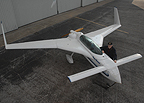March 14, 2008
Composite aircraft donation benefits students
CARBONDALE, Ill. — For Jacob O. Bach, the choice was an easy one when considering the future of the "Norse Nomad."
The retired Southern Illinois University Carbondale professor's gift — the result of a lifetime love of flying — will help current and future aviation technology students learn about composite aircraft.
Bach recently donated his "Long EZ" experimental aircraft to the University's Department of Aviation Technologies program. The retired professor in educational leadership spent almost 2,000 hours over four years building the "Norse Nomad," a composite plane of fiberglass and foam, before finishing the project in 1983.
"It's been a wonderful plane to fly," said Bach, who lives in Carbondale with Theodora, or "Tippy," his wife of 65 years. Bach taught at SIUC for 30 years, and is a former department chair of educational administration and supervision.
The plane, a design of experimental aircraft innovator Burt Rutan, logged 813 hours in the air, making trips to Texas and Minnesota, and at least three journeys to the annual Experimental Aircraft Association air shows in Oshkosh, Wis. Bach, now 88, made his last flight in the "Norse Nomad" in November 2006. The plane's wingspan is 26 feet.
Bach's flying goes back to his college years at La Crosse State Teacher's College — now the University of Wisconsin-La Crosse —when he flew Tippy in Piper Cub airplanes. A retired commander in the U.S. Navy, Bach flew a twin-engine Martin Mariner seaplane during World War II. He received two Distinguished Flying Crosses, four Air Medals, and six service ribbons.
"I empathize with Jake. Flying has been a big part of his life," said Tippy, who also rode with Bach in the "Norse Nomad."
He received inquiries on selling the experimental airplane, but there were liability concerns, he said.
"I decided I would rather give it to the University," Bach said. He built the plane with help from University staff, including retired aviation technologies faculty member Paul Burkey, and assistant professor Charles L. Rodriguez.
The plane will not fly again. The donation benefits students' practical experience in many ways, said John D. Cotter, an assistant professor and interim chair of aviation technologies. Students will learn to make repairs on composite aircraft, an important consideration since new aircraft — Boeing 787s are up to 80 percent composite, by volume — are utilizing increasing percentages of composite materials, he said.
"That's good because they will be working with composite structures a lot more of when they go out into the field," he said.
The plane's Lycoming aircraft engine has solid lifters and is a "very valuable" addition to the department's existing engine group, Cotter said.
"It's very difficult for us to come up with engines," he said. "It's a good addition because it is an operable engine, and we will be able to use it in our powerplant testing course."
The engine gives students an opportunity to work on valve train adjustments, a capability the department didn't have with its other engines, Cotter said.
The kit plane is no longer built, said Keven R. Mitchell, an assistant professor in aviation technologies. The donation provides research opportunities into stress fractures on the plane, he said.
"We are really excited about it," he said. "This is something you just normally read about because there aren't very many of them around."
The Department of Aviation Technologies is within the College of Applied Sciences and Arts.
Caption:
Norse Nomad — Retired Southern Illinois University Carbondale professor Jacob O. Bach stands with his experimental aircraft, the "Norse Nomad," which he recently donated to the University's Department of Aviation Technologies.
Photo by Steve Buhman, University Communications

